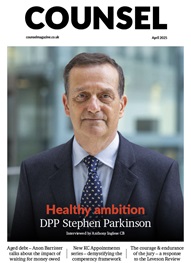*/
There is an ‘urgent need’ for positive action to increase the number of women and ethnic minority lawyers on the bench, the Bar Council said after statistics revealed a ‘serious problem’ with appointments.
The latest figures released by the Judicial Appointments Commission revealed that ethnic minority candidates made up 20% of applicants, but only 6% of appointments, they were disproportionately less likely to succeed in applying to be High Court and Circuit Judges, and none had applied for senior judicial roles.
Women made up 42% of applicants, but accounted for only 35% of appointments. While their success rate in applying to be High Court judges was proportionate to those who applied, women made up only 35% of the pool of applicants.
The Bar Council said the figures showed a ‘serious problem’ with appointments and underlined the need for ‘targeted support and training’.
Robin Allen QC, Chair of the Bar Council’s Equality and Diversity Committee, said: ‘We cannot go on having no [ethnic ninority] applications for senior judicial roles. The rule of law requires a fully diverse judiciary.
‘Once again the figures reveal the urgent need for positive action,’ he said.
The Bar Council is working in partnership to develop a programme of pre-application judicial education for those thinking of applying, with places reserved for people from under-represented groups.
More positively, of the 21 new deputy High Court judges announced last month, seven were women, five were solicitors and some were the first in their family to have attended university.
There is an ‘urgent need’ for positive action to increase the number of women and ethnic minority lawyers on the bench, the Bar Council said after statistics revealed a ‘serious problem’ with appointments.
The latest figures released by the Judicial Appointments Commission revealed that ethnic minority candidates made up 20% of applicants, but only 6% of appointments, they were disproportionately less likely to succeed in applying to be High Court and Circuit Judges, and none had applied for senior judicial roles.
Women made up 42% of applicants, but accounted for only 35% of appointments. While their success rate in applying to be High Court judges was proportionate to those who applied, women made up only 35% of the pool of applicants.
The Bar Council said the figures showed a ‘serious problem’ with appointments and underlined the need for ‘targeted support and training’.
Robin Allen QC, Chair of the Bar Council’s Equality and Diversity Committee, said: ‘We cannot go on having no [ethnic ninority] applications for senior judicial roles. The rule of law requires a fully diverse judiciary.
‘Once again the figures reveal the urgent need for positive action,’ he said.
The Bar Council is working in partnership to develop a programme of pre-application judicial education for those thinking of applying, with places reserved for people from under-represented groups.
More positively, of the 21 new deputy High Court judges announced last month, seven were women, five were solicitors and some were the first in their family to have attended university.


Now is the time to tackle inappropriate behaviour at the Bar as well as extend our reach and collaboration with organisations and individuals at home and abroad
A comparison – Dan Monaghan, Head of DWF Chambers, invites two viewpoints
And if not, why not? asks Louise Crush of Westgate Wealth Management
Marie Law, Head of Toxicology at AlphaBiolabs, discusses the many benefits of oral fluid drug testing for child welfare and protection matters
To mark International Women’s Day, Louise Crush of Westgate Wealth Management looks at how financial planning can help bridge the gap
Casey Randall of AlphaBiolabs answers some of the most common questions regarding relationship DNA testing for court
Maria Scotland and Niamh Wilkie report from the Bar Council’s 2024 visit to the United Arab Emirates exploring practice development opportunities for the England and Wales family Bar
Marking Neurodiversity Week 2025, an anonymous barrister shares the revelations and emotions from a mid-career diagnosis with a view to encouraging others to find out more
David Wurtzel analyses the outcome of the 2024 silk competition and how it compares with previous years, revealing some striking trends and home truths for the profession
Save for some high-flyers and those who can become commercial arbitrators, it is generally a question of all or nothing but that does not mean moving from hero to zero, says Andrew Hillier